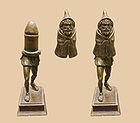
Hooded Spirits
Encyclopedia
The Hooded Spirits or Genii Cucullati are figures found in religious sculpture across the Romano-Celtic region from Britain
to Pannonia
, depicted as "cloaked scurrying figures carved in an almost abstract manner" (Henig, 62). They are found with a particular concentration in the Rhineland
(Hutton). In Britain they tend to be found in a triple deity
form, which seems to be specific to the British representations (De la Bedoyère).
The hooded cape was especially associated with Gauls or Celts during the Roman period. The hooded health god was known as Telesphorus
specifically and may have originated as a Greco-Gallic syncretism with the Galatians in Anatolia in the 3rd century BC.
The religious significance of these figures is still somewhat unclear, since no inscriptions have been found with them in this British context (De la Bedoyère). There are, however, indications that they may be fertility spirits of some kind. Ronald Hutton
argues that in some cases they are carrying shapes that can be seen as eggs, symbolizing life and rebirth, while Graham Webster has argued that the curved hoods are similar in many ways to contemporary Roman curved phallus stones. However, several of these figures also seem to carry swords or daggers, and Henig discusses them in the context of warrior cults.
Guy de la Bédoyère
also warns against reading too much in to size differences or natures in the figures, which have been used to promote theories of different roles for the three figures, arguing that at the skill level of most of the carvings, small differences in size are more likely to be hit-and-miss consequences, and pointing out that experimental archaeology
has shown hooded figures one of the easiest sets of figures to carve.

Roman Britain
Roman Britain was the part of the island of Great Britain controlled by the Roman Empire from AD 43 until ca. AD 410.The Romans referred to the imperial province as Britannia, which eventually comprised all of the island of Great Britain south of the fluid frontier with Caledonia...
to Pannonia
Pannonia
Pannonia was an ancient province of the Roman Empire bounded north and east by the Danube, coterminous westward with Noricum and upper Italy, and southward with Dalmatia and upper Moesia....
, depicted as "cloaked scurrying figures carved in an almost abstract manner" (Henig, 62). They are found with a particular concentration in the Rhineland
Rhineland
Historically, the Rhinelands refers to a loosely-defined region embracing the land on either bank of the River Rhine in central Europe....
(Hutton). In Britain they tend to be found in a triple deity
Triple deity
A triple deity is a deity associated with the number three. Such deities are common throughout world mythology; the number three has a long history of mythical associations. C. G...
form, which seems to be specific to the British representations (De la Bedoyère).
The hooded cape was especially associated with Gauls or Celts during the Roman period. The hooded health god was known as Telesphorus
Telesphorus (mythology)
In Greek mythology, Telesphorus was a son of Asclepius. He frequently accompanied his sister, Hygieia. He was a dwarf whose head was always covered with a hood or cap....
specifically and may have originated as a Greco-Gallic syncretism with the Galatians in Anatolia in the 3rd century BC.
The religious significance of these figures is still somewhat unclear, since no inscriptions have been found with them in this British context (De la Bedoyère). There are, however, indications that they may be fertility spirits of some kind. Ronald Hutton
Ronald Hutton
Ronald Hutton is an English historian who specializes in the study of Early Modern Britain, British folklore, pre-Christian religion and contemporary Paganism. A reader in the subject at the University of Bristol, Hutton has published fourteen books and has appeared on British television and radio...
argues that in some cases they are carrying shapes that can be seen as eggs, symbolizing life and rebirth, while Graham Webster has argued that the curved hoods are similar in many ways to contemporary Roman curved phallus stones. However, several of these figures also seem to carry swords or daggers, and Henig discusses them in the context of warrior cults.
Guy de la Bédoyère
Guy de la Bédoyère
Guy Martyn Thorold Huchet de la Bédoyère is a British historian, who has published widely on Roman Britain and other subjects, and has appeared regularly on the Channel 4 archaeological television series, Time Team. In 1999 he presented a three-part series called The Romans in Britain for BBC2,...
also warns against reading too much in to size differences or natures in the figures, which have been used to promote theories of different roles for the three figures, arguing that at the skill level of most of the carvings, small differences in size are more likely to be hit-and-miss consequences, and pointing out that experimental archaeology
Experimental archaeology
Experimental archaeology employs a number of different methods, techniques, analyses, and approaches in order to generate and test hypotheses, based upon archaeological source material, like ancient structures or artifacts. It should not be confused with primitive technology which is not concerned...
has shown hooded figures one of the easiest sets of figures to carve.


